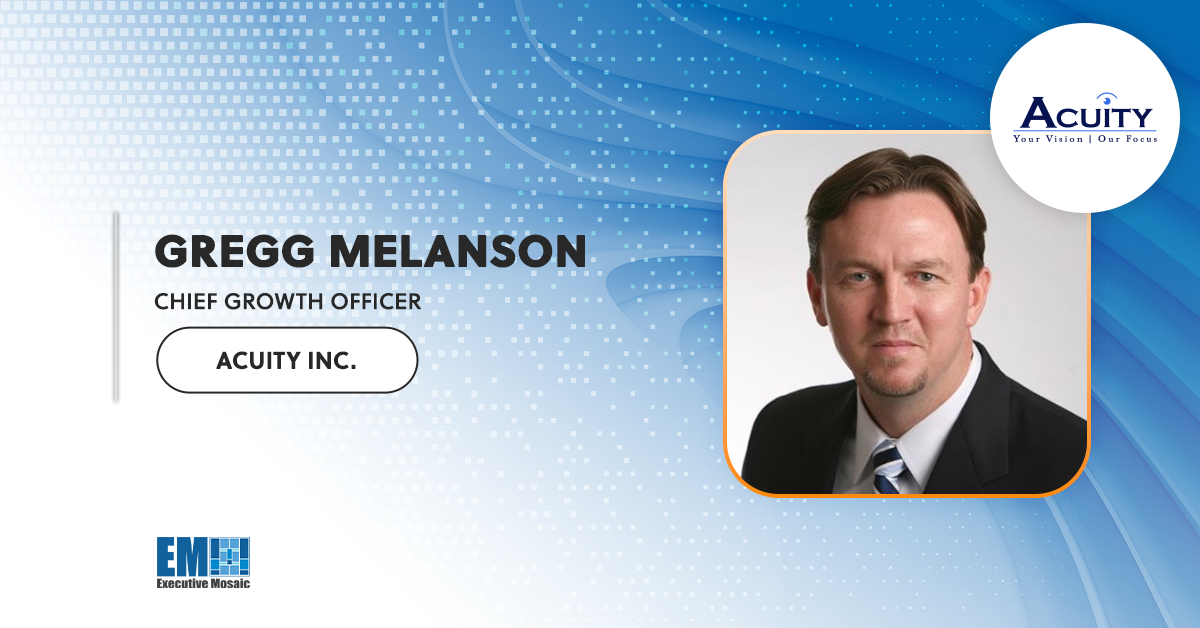Data is the key to unlocking important insights that can inform decisions on and off the battlefield. But in order to glean these insights, organizations must process and analyze vast amounts of data, which can be a significant challenge.
Executive Mosaic spoke with Gregg Melanson, chief growth officer at Acuity, to get a better understanding of how federal agencies can overcome their data challenges and use analytical insights to achieve decision advantage. Melanson also spoke about Acuity’s growth in the intelligence community market and what advancements in artificial intelligence might mean for the future of data analytics.
Read below for Melanson’s full Executive Spotlight interview.
To set the scene for our conversation, can you talk a little bit about the cyber/IT landscape? What are the major trends you’re noticing?
This is the million-dollar question. To me, the most predominant trend in the IT federal landscape is the need to do more with less. There are budget challenges, emerging technologies, advanced cyber threats — especially threats from hackers overseas — and tons of data to deal with. There are limited resources within the federal space to address all this, and that is the most challenging factor hitting the federal market right now. How we handle it is going to be of critical importance.
I think there’s an additional challenge in that you really can’t solve tomorrow’s problems with yesterday’s tools. I see the federal market trying to determine how they handle IT modernization. Do they do it piece by piece? Do they do it in one ‘big bang’ approach? How do they implement that? With AI, hyper-automation and all the different tools that are in the marketplace now, I think federal agencies are going to get very creative very soon in how they deal with all these things.
Gregg, I know you joined Acuity as chief growth officer in September of 2023. What can you tell us about your growth strategy for the company?
Our focus is on supporting federal customers as they increase their use of digital systems and intelligent platforms. How do we take those tools — modernized tools, hyper-automation tools — and bring them in as a force multiplier? Again, how do we empower one person to have the productivity of five? Our growth targets are centered on providing the biggest bang for the buck for our federal marketplace customers, making them far more productive with smaller tool sets in hand.
Data and data enablement is also a priority for us. The U.S. federal government collects a tremendous amount of data, and there are nuggets of wisdom in that data. How do we help them find those nuggets? We provide tools to help them combat data overwhelm and uncover actionable insights. Overall, we see a lot of growth potential in the areas of data modernization and automation tools.
Where are you seeing opportunities for expansion in Acuity’s portfolio? What new capabilities or markets are you eyeing?
We have a dedicated group at the company, our Technology Solutions Group, that focuses on R&D in the federal market. They aim to expand Acuity’s portfolio with unique tools and techniques that differentiate us in the market. They do that by looking at the complex challenges facing our federal marketplace customers. We then collaborate with our customers as well as our partner companies and vendors such as Microsoft, AWS and ServiceNow to create solutions. Sometimes the problems have similarities, but not always. We’re especially interested in those situations where one solution can address many problems.
Acuity is also expanding our portfolio to support the intelligence community. We are doing this by leaning on our experience and our two decades of hard work within the federal civilian market. Our Department of State and Department of Homeland Security work is tremendous, and it has provided us with a mechanism to move into the intelligence community. We are currently working with a number of IC partners, and we’re happy to say that’s going very well. We see that as a major growth area for us.
Data must be collected, analyzed and understood in order to be used effectively. What are some of the key challenges and opportunities you’re seeing emerge as organizations harness data and use it to drive decisions?
The sheer amount of data available is a daunting challenge, and all agencies face it — the IRS, Department of State with all the visa applications, Department of Homeland Security with the border crossings and the tremendous amounts of information that they have. The challenge is pretty straightforward: the influx of data doesn’t stop and it doesn’t take a day off. Data continues to flow in. If you are not ready for that, if you don’t have the proper governance and rules in place, you can start to have trust issues with the data. Do you really trust all this data? Is it telling you the right things?
The men and women in the federal market make decisions based on this information. They have to trust it. They have to know that it is valid. If not, they might make a decision based on incorrect data.
Acuity is always looking at modern tools such as artificial intelligence, machine learning and intelligent platforms including Microsoft Power Platform, ServiceNow and others, that are built to handle large amounts of data at scale. These modern tools, used to their best advantage, give us the opportunity to provide the U.S. federal government with a trusted, well-governed source of information. They will be able to see things they didn’t see before and learn things that they need to know to do their jobs. It’s not an easy challenge, but Acuity’s ready to take it on.















